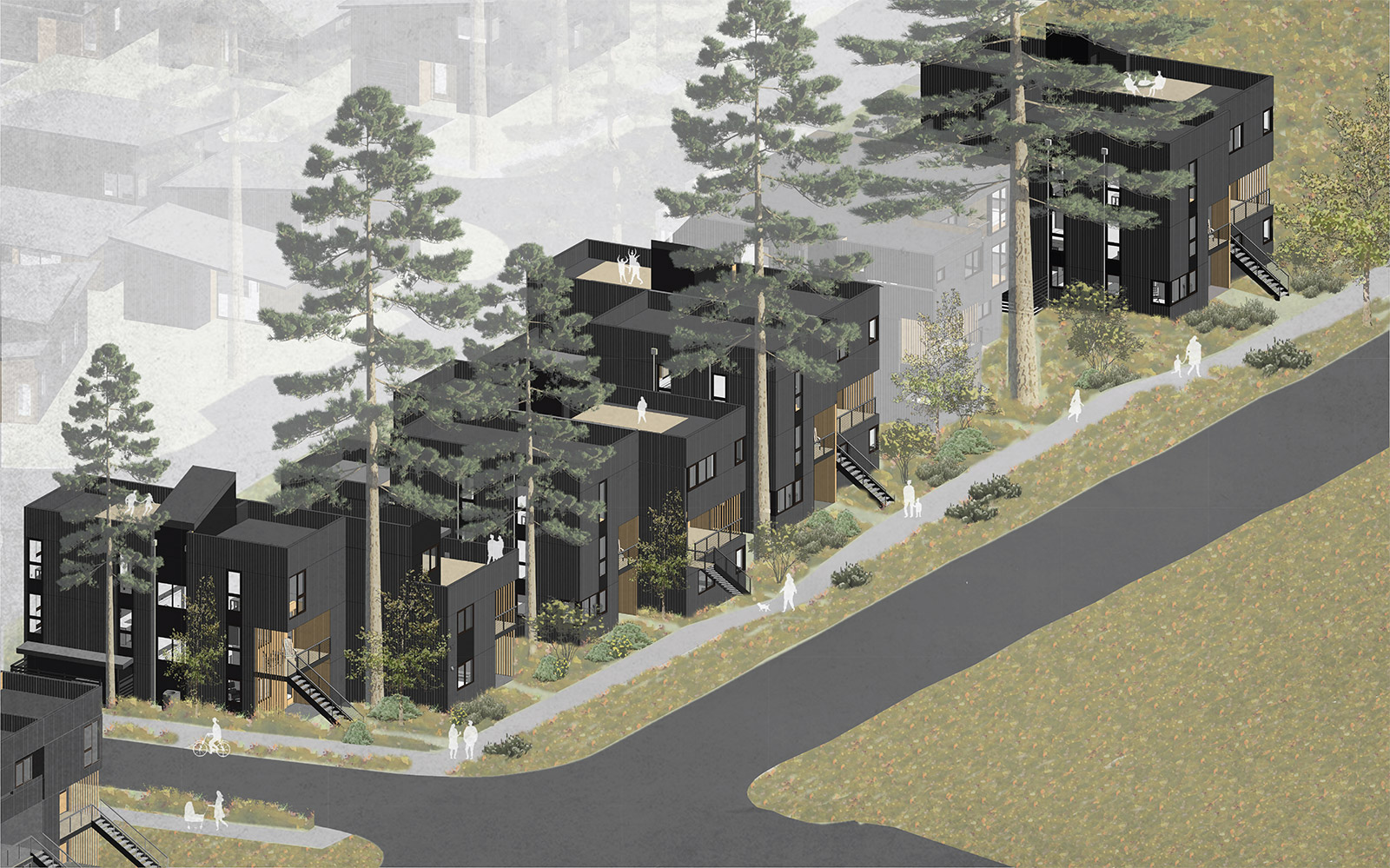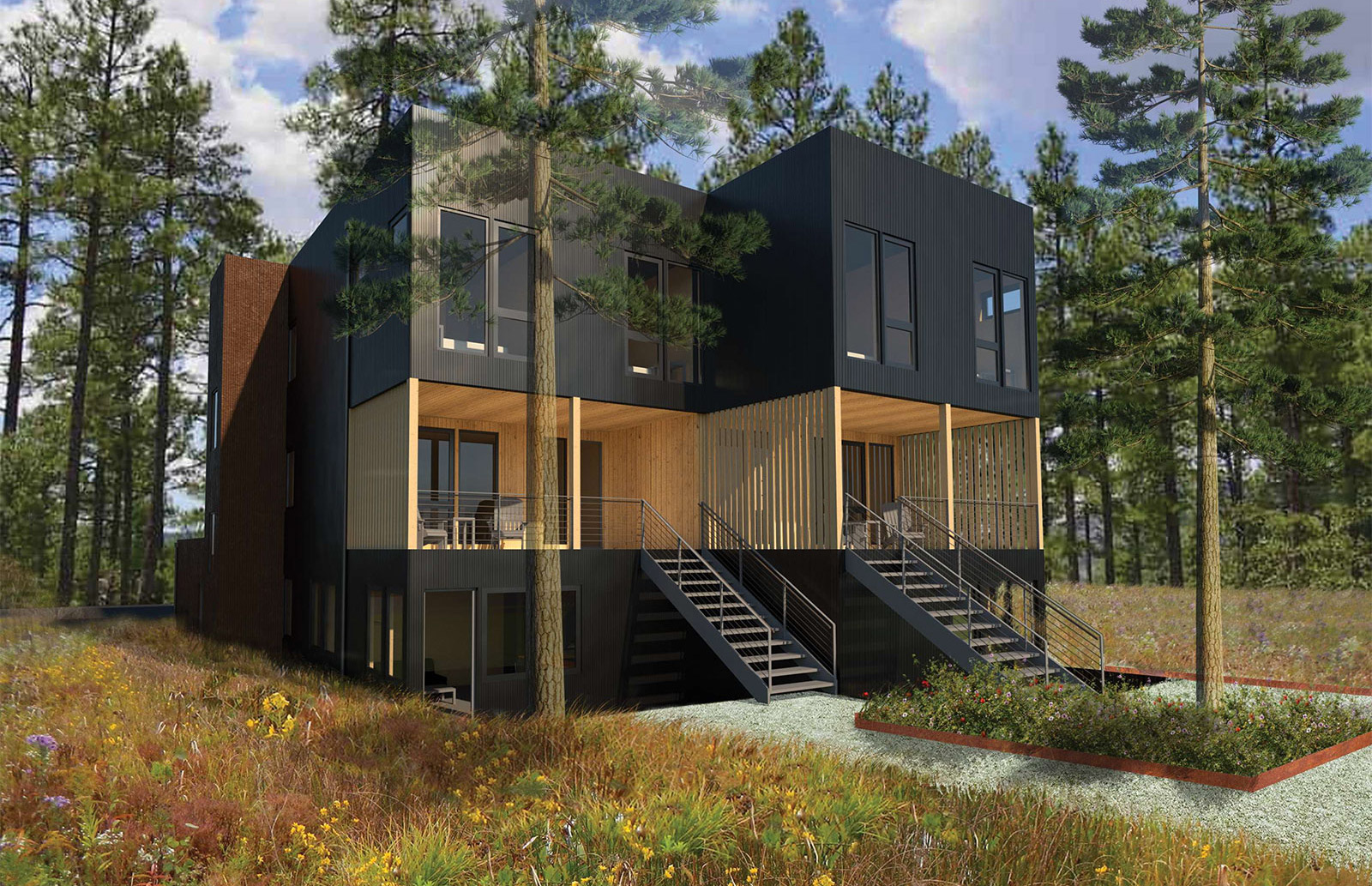
[Renderings by BUILD LLC]
One of the biggest shifts resulting from the pandemic has been the shift to remote work, and for many of us to reassess, and reimagine our homes. This newfound freedom and introspection has inspired millions of Americans to pick up and move to take advantage of their new flexible lifestyles, and search out a new way of living. According to Forbes, in 2022 roughly 9.3% of people were planning on moving because of remote work.
Without the need to commute to the office, urban living just doesn’t have the same draw that it used to. The trend is very clear: families are reassessing how they live; they want their homes to have more program flexibility, and workers are moving out of cities in favor of a quieter, more natural setting. Places like Sisters, Oregon.
The problem is, many of these transplants envision a single-family house sitting on its own plot of land, nestled in the countryside. The unfortunate reality is that these plots of land are extremely hard to find. They are either exorbitantly expensive, or come with too many acres, which may obligate the Central Oregon homeowner to use it for agricultural purposes. For the few who may be able to afford a property on the outskirts of town, they are so remote that they lose a sense of community and walkability; people don’t know their neighbors and have to get into their cars frequently. Further, due to the expense and lack of available property — not to mention the high costs to build and maintain that extra infrastructure — single-family homes add to the real estate pricing escalation feedback loop. Despite the deeply-rooted nature and desirability of single family-home ownership in our country, we must face the fact that it is becoming outdated.
But what if we could provide a type of housing that takes the benefits of urban living and puts them in a natural setting?
Woodlands checks all the right boxes. Located on an idyllic site in the heart of Sisters, this 32-acre parcel is surrounded by earthly wonders and endless outdoor activities, but is still only a short walk to downtown and all available services. And yet, despite its proximity to the town center, it doesn’t feel like it is in the heart of a town. Woodlands was painstakingly designed to save over half (500!) of the existing ponderosa pines that are native to the site; parks and outdoor amenity spaces were intentionally fashioned throughout, and the landscape was designed to integrate drought-tolerant and native plant species among the preserved pines.
Perfect site: Check.

Next, housing. For the last couple of years, we’ve been hard at work reimagining what the next generation of the single-family home could be. We’ve developed a range of housing options that are geared toward a diverse mix of people, while striving to achieve the right balance of urban and rural life. For the purposes of this article, we focus on the option that may be suited for the widest range of people.
The Sisters Woodlands Townhouse
While traditionally an urban building type, the townhouse is a perfect fit for this site for many reasons. The shared wall between the two structures keeps the footprint efficient, allowing two homes to occupy a smaller site. This helps keep building and energy costs down, and allows for more density in a place that desperately needs more housing. With their tidy footprints, the townhouses are vertically oriented, which enhances the feeling of being nestled in the preserved ponderosa pines. Further, they have what can only be described as totally killer roof terraces. In our experience, these get tremendous use, as they provide so much function and enjoyment for the homeowners and their friends.

The most important reason why these townhouses are perfectly suited for Sisters is because each one includes two dwellings: the main home, and an accessory dwelling unit (ADU). These fully autonomous ADUs have their own kitchens, bathrooms, bedrooms, common areas, and their own, relatively private, entries.

 By providing two separate homes in one, homeowners gain additional options and the opportunity to balance their mortgages. If the ADU is used for an aging-in-home parent or adult kid just starting out, what a terrific way to span generations *and* share housing costs among generations. A recent PEW Research Center study spanning 50 years of data (right) indicates the growing popularity of multigenerational living in the U.S.
By providing two separate homes in one, homeowners gain additional options and the opportunity to balance their mortgages. If the ADU is used for an aging-in-home parent or adult kid just starting out, what a terrific way to span generations *and* share housing costs among generations. A recent PEW Research Center study spanning 50 years of data (right) indicates the growing popularity of multigenerational living in the U.S.
Pretty much every country except our own has embraced a multi-generational approach to housing for centuries, and there are familial and financial advantages that we Americans should take note of. Per the JCHS study below, foreign-born Americans are leading the way here in the U.S. with a 5 to 20-percent increase of multigenerational living.

[Graph via Joint Center for Housing Studies of Harvard University]
If the ADU is being held for an extended family member for a later time, what a great opportunity to rent it to any number of young schoolteachers or first responders trying to gain housing traction in the local community. The design re-engineers the layout and function of the American home, and the financial template, allowing owners more economic leverage. This model is a culmination of 20+ years of researching, studying, developing, designing, permitting, and building just about every type of housing that exists; in our humble opinion, we offer that this is thoughtful and effective in function, durability, and sustainability. In our never-ending search to create welcoming and long-lasting homes, these models are a new template for increasing access to housing.


If you’re interested in learning more about these townhomes, head on over to the Sisters Woodlands website and for those ready to take action, the MLS can be found here.
Cheers from team BUILD






